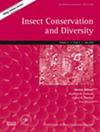Pollinators respond positively to urban green space enhancements using wild and ornamental flowers
IF 3.2
2区 农林科学
Q1 ENTOMOLOGY
引用次数: 0
Abstract



授粉昆虫对利用野生花卉和观赏花卉改善城市绿地作出积极回应
传粉昆虫的多样性和数量正受到人类活动的直接威胁。尽管社会依赖传粉昆虫进行作物生产,但人类继续通过农业集约化和城市化推动传粉昆虫的减少。城市环境可以为一些传粉昆虫提供庇护。然而,有必要了解如何在这些地区支持传粉昆虫群落,同时考虑人类的需求。由于公共绿地面积大、丰度高、植物授粉昆虫生物多样性低,因此为在城市环境中采取植物授粉昆虫保护措施提供了一个很有前景的途径。我们采用配对设计,比较了(i) 采用野花草地和授粉昆虫友好型观赏植物强化的城市公共绿地与(ii) 未强化的城市公共绿地的植物群落、授粉昆虫群落以及植物与授粉昆虫之间的相互作用。我们还分别比较了强化场地内的种植类型。我们的研究结果表明,与对照组相比,改善后的绿地不仅整体传粉昆虫群落的多样性更高,而且一些野生膜翅目昆虫的复杂性和双翅目传粉昆虫群落的丰富性也更高。与对照地点相比,城市化对某些传粉昆虫群落的负面影响在强化地点有所减少。与只种植野花相比,同时种植对授粉者友好的观赏植物和野花草甸可显著增加双翅目传粉者的访问量和植物-授粉者群落的多样性。我们的研究结果表明,为传粉昆虫改善公共空间对主要群体有积极影响,有助于减轻城市化带来的影响。非本地观赏植物在保持其休闲功能的同时,也能在为传粉昆虫改善绿地方面发挥作用。这支持采用混合种植的方法来改善城市地区的公共绿地,以造福人类和自然。
本文章由计算机程序翻译,如有差异,请以英文原文为准。
求助全文
约1分钟内获得全文
求助全文
来源期刊
CiteScore
7.70
自引率
8.60%
发文量
58
审稿时长
>12 weeks
期刊介绍:
To publish papers of the highest scientific quality within the general area of insect (and other arthropods) conservation and diversity covering topics ranging from ecological theory to practical management.
Papers are invited on the following topics: Conservation genetics; Extinction debt; Long-term conservation planning and implementation; Global implications of local or national conservation actions; Management responses of species and communities; Captive breeding programs; Comparisons of restored and natural habitats; Biogeography; Global biodiversity; Metapopulation dynamics; Climate change: impacts on distributions and range; Invasive species: impacts and control; Effects of pollution; Genetic threats to diversity by introgression; Effects of fragmentation on diversity and distribution; Impact of agricultural and forestry practices on biodiversity; Enhancing urban environments for diversity and protection; Biodiversity action plans: can we scale up from insects?; Effectiveness and choice of indicator species; Soil biodiversity and interactions with above-ground biodiversity; Ecological interactions at local levels; Ecological and evolutionary factors influencing diversity and local, regional and global scales; Sustainable livelihoods and training on the ground; Integrating science and policy.

 求助内容:
求助内容: 应助结果提醒方式:
应助结果提醒方式:


